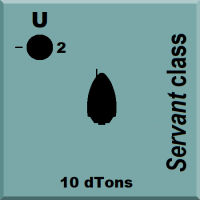Servant class Launch
| Servant class Launch | |
|---|---|
 AAB Ship Reference File. | |
| Type: UML Smallcraft | |
| Category | Smallcraft |
| Size | 10 Tons |
| Hull Configuration | Cone Hull |
| Streamlining | Streamlined Hull |
| Tech Level | TL–9 |
| Engineering | |
| Computer | Model/1 (Model/0) |
| Jump | J-0 |
| Maneuver | 2 G |
| Armaments | |
| Hardpoints | 1 |
| Accommodations | |
| Staterooms | 0 |
| Personnel | |
| Crew | 1 |
| Officers | 1 |
| High/Mid Passengers | 0 |
| Payload | |
| Cargo | 0/5 Tons |
| Fuel tank | 0 Tons |
| Construction | |
| Origin | Unknown |
| Year Operational | No information yet available. |
| End of Service | Still in active service. |
| Price | |
| Cost | MCr6.160 (base) MCr4.928 (qty) |
| Architect fee | MCrAde Stewart |
| Statistics | |
| Quick Ship Profile | UML-1A20 |
| Images | |
| Blueprint | No |
| Illustration | Yes |
| Source | |
| Also see | Utility Craft |
| Canon | Published, fan design |
| Era | 1105 |
| Reference | Fan: Ade Alagoric Stewart |
| Starships are designed with the Classic Traveller format, using Book 5 High Guard | |
The Servant class Launch is a noncombatant smallcraft.
- It is a Civilian Ship, a Utility Craft, and a Launch.
- It is a common service craft carried aboard larger vessels.
Description (Specifications)[edit]
The Launch is designed to ferry passengers and incidental cargoes between locations.
- It is a TL–9 design.
The class are ubiquitous, manufactured in shipyards by the hundred.
Image Repository[edit]
General Description[edit]
The Servant class is a utility vessel with 2-G performance. It is supplied unarmed, though it is common practise for crews to retrofit weapon systems. It has a broadly cone-shaped profile and is fully streamlined, allowing atmospheric operations and enabling it to perform surface landings.
Basic Ship Characteristics[edit]
Following the Imperial Navy and IISS Universal Ship Profile and data, additional information is presented in the format shown here. The small craft factor indicates the number of squadrons (...of ten subcraft) carried on the ship. Tonnage on the universal ship profile is shown in kilotons (...thousands of tons) where necessary. [1]
| Basic Ship Characteristics [2] | ||
|---|---|---|
| No. | Category | Remarks |
| 1. | Tonnage / Hull | The Servant class Launch is constructed using a 10 dTon hull built in a generally cone-shaped configuration. The hull is fully streamlined, giving reasonable atmospheric performance that is further enhanced by airfoil surfaces and its onboard gravitic systems.
|
| 2. | Crew | Total Crew Complement: 1
Accommodations The main compartment has x10 removable passenger acceleration couches.
The vessel is fitted with grav plates and inertial compensators and has full life support and environmental systems.
|
| 3. | Performance | The vessel mounts a Maneuver-2 drive and a Power Plant-2, giving performance of 2-G acceleration. The ship has an agility rating of 2. The internal fuel tankage is sufficient to give the power plant approximately 4 weeks duration.
|
| 4. | Electronics | The cockpit contains x2 side by side acceleration couches, both with control equipment. The vessel is fitted with a Model/1 Computer: no backup Computer is installed.
The vessel is fitted with communications equipment, a basic sensor array, and has an Avionics suite.
|
| 5. | Hardpoints | x1 hardpoint. |
| 6. | Armament | The Launch is unarmed. |
| 7. | Defenses | The hull is unarmored.
|
| 8. | Craft | The vessel carries no subcraft. |
| 9. | Fuel Treatment | The vessel has internal fuel tankage of 1 dTon.
|
| 10. | Cost | The basic cost of the vessel is MCr6.160.
|
| 11. | Construction Time | 24 weeks (5.5 months) as standard.
|
| 12. | Comments | If the passenger couches are removed the craft has a cargo capacity of up to 5 dTons. |
History & Background (Dossier)[edit]
Launches are extremely common utility craft. The Servant class is a smaller example of the type.
- Huge numbers of the class have been built.
Class Naming Practice/s & Peculiarities[edit]
Vessel Peculiarities:
The Servant class is supplied unarmed: it is normal practise for crews to add armaments to the hardpoint. The vessel does not have sufficient power for lasers or energy weapons, restricting the options to missiles or sandcasters.
Class Naming Practice/s:
Launches do not generally have official names, though they may be named by their crews.
- Individual vessels are issued specific serial numbers and transponder codes.
Selected Variant Types & Classes[edit]
Civilian Ship - Utility Craft - Smallcraft - Launch:
Civilian Ship- Smallcraft - Utility Craft:
References & Contributors (Sources)[edit]
| This article has metadata. |
- Marc Miller, Frank Chadwick, John Harshman. High Guard (Game Designers Workshop, 1980), 20-37. (Design Sequence Used)
- Author & Contributor: Lord (Marquis) and Master Scout Emeritus Adie Alegoric Stewart of the IISS
- Author & Contributor: Deekay Krause
- ↑ Timothy B. Brown. Fighting Ships (Game Designers Workshop, 1981), 10.
- ↑ Timothy B. Brown. Fighting Ships (Game Designers Workshop, 1981), 10.
